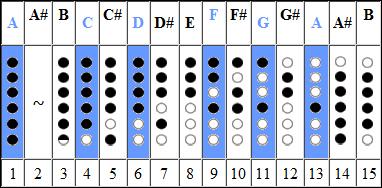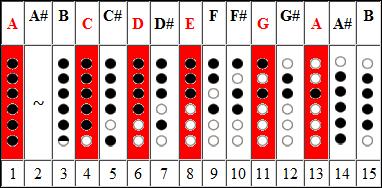Mode Four Pentatonic Scale
Up until this point you have be playing your flute in the Mode One pentatonic scale. While playing this scale you have kept the fourth hole from the bottom of the flute closed with your left hand ring finger. Now we are going to learn the Mode Four pentatonic scale. In this scale you will be opening up that poor little fourth hole. Refer to the diagram below to see how this scale is played.
Key of A / A# /B /C /C# /D /D# /E /F /F# /G /G# /A flute playing mode four scale.
Bolded notes are the mode four notes.

As you can see, you progress up the flute but you keep your right index finger over the third hole. And you open the fourth hole by lifting the left index finger. By doing this you create a different sequence of notes and a thus a different scale. Listen carefully to the new flavor of scale that you are playing. You can refer to the diagram above to see the names of the new notes in this scale. As you can see the only difference is that you are playing an F instead of an E as your fourth note in the scale. This changes the intervals between the notes from 3, 2, 2, 3, 2 to 3, 2, 3, 2, 2. I hope that I’m note confusing you. Remember that you don’t need to know the theory to play great music.
Having two different scales to play in increases the breath of possibilities for your flute playing. Experiment with this scale until get to know it well. Some people say they like it better than mode one. What do you think?
With a little experimentation you will find new tunes emerging from this scale. For those of you with an enquiring mind the difference between the two scales stems from different intervals between the notes in the scale. In mode one the intervals between the notes are 3,2,2,3,2 and in mode four the intervals are 3,2,3,2,2. What, you may ask, am I talking about. Intervals are the distance that one note is from another. If you refer to the diagram for a flute in the key of A mode one scale you will see the mode one scale highlighted in red. Then in the diagram above you will see the mode four scale highlighted in blue. Note the distance between the highlighted notes. These are the intervals. As you can see there are twelve possible notes on the diagram. These are the notes of what is called a chromatic scale. I won’t burden you with more information on this subject now. I just want you to see a graphic representation of what notes you are making as you play your flute in two different modes.
Cross Fingering
Key of A /A# /B /C /C# /D /D# /E /F /F# /G /G# /A flute playing mode one scale.

I don't expect you to take on this part of the lesson right away. It took me several years to get to this point in my learning.
Now we will add some more new notes to our flute playing. We will do this by employing a technique called cross fingering.
Refer to the diagram above for a Native American style flute in the key of A (your flute may not be an A but the principles are the same). In this diagram you will see that there are notes available if you use different finger placements than the ones we have already studied. Sound your fundamental note and then the note that is created by opening hole number one. Now, we will play a new note on our flute by putting the ring finger of the right hand back down on its hole and opening hole two by lifting the middle finger of the right hand. Look on the diagram and find the new note that you have sounded. It is shown as note number five. This note is in neither the mode one nor mode four scale. Notice that it sounds strangely out of tune – like it doesn’t belong. Isn’t it amazing that our ear intuitively recognizes what does and does not belong in a tonal sequence of notes. If used in a composition played in mode one or four this note would be called a grace note. A grace note is a little something extra thrown in to add just a touch of unusual flavor to the composition.
Now lift the index ring finger off the first hole and play the third note of the mode one scale. To get another new note take the index finger off of hole three and put the middle finger down on hole two. This gives you another new note that is in neither the mode one nor mode four scales. It’s another grace note.
Looking at the chart you see that note number ten can be made by having the right index, left ring and left index fingers covering their holes and leaving the other holes open. And, note number twelve is made by having the left ring and middle fingers down while all the other fingers are up.
I assume that you will continue to experiment with these new notes (or maybe not) until you find places for them in your improvisations. As I have said, they are grace notes seldom used but there when you want to add a little sauce to the sound.
When you have mastered the fingerings of these new chromatic notes you will be able to play some music that employs diatonic major scales such as the tune Amazing Grace.
Back to Start - Flute Tutorial: Lesson 1
Previous Lesson - Flute Tutorial: Lesson 4
